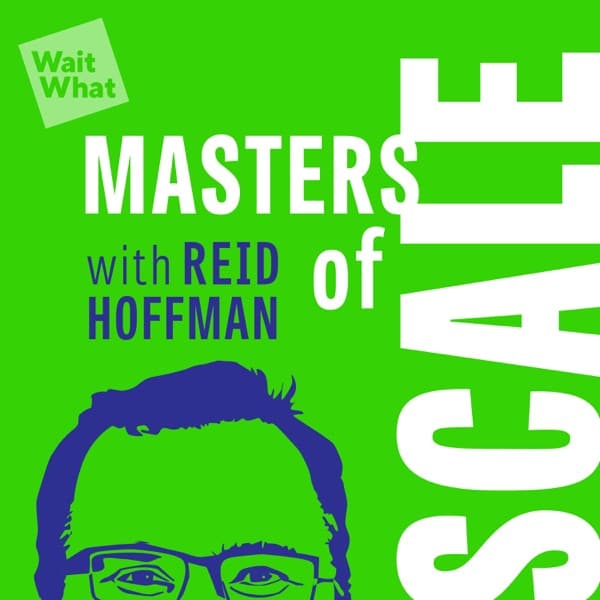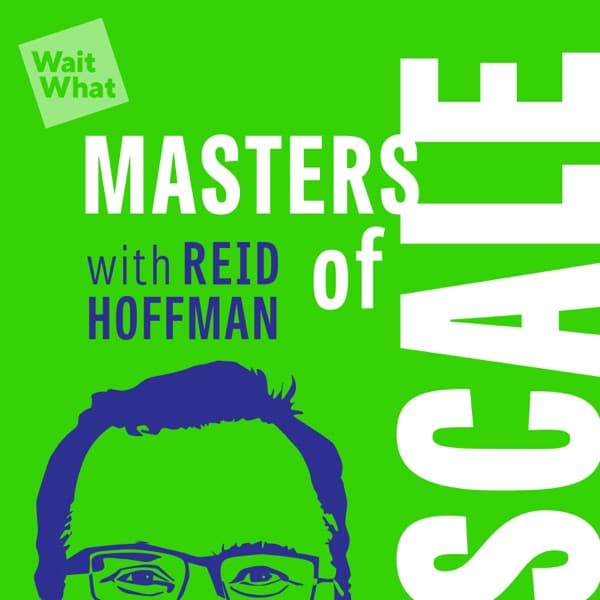All-In Podcast: The speaker expresses concern about economic factors like tariffs, slowing immigration, and austerity, predicting a potential market correction.
All-In Podcast: The discussion focuses on economic concerns, market corrections, and political strategies in the context of austerity and asset markets.
FirstRoundCapital: The video discusses a workflow using Clay to solve customer problems quickly and effectively, enhancing customer engagement and product feedback.
Modern Wisdom: The discussion explores the complexity of human emotions, the challenges of understanding them, and practical strategies for managing emotions, overthinking, fear, and relationships.
How I Built This with Guy Raz: The episode discusses Max Levchin's journey from founding PayPal to its growth and eventual sale to eBay, highlighting the challenges and innovations along the way.
The Twenty Minute VC (20VC): Venture Capital | Startup Funding | The Pitch: The discussion explores the evolving role of AI in business, emphasizing the importance of differentiated data, go-to-market strategies, and the potential of AI to transform industries like healthcare and software development.
TechCrunch Startup News: Inception, a company founded by Stanford professor Stefano Erman, developed a diffusion-based large language model (DLM) that offers faster performance and reduced costs compared to traditional LLMs.
TechCrunch Startup News: Relay is revolutionizing parcel delivery in Europe with an AI-driven, asset-light model inspired by Asia's e-commerce delivery systems.
All-In Podcast - Market Correction Coming Soon? Chamath Explains
The speaker aligns with the perspective of Stevie Cohen, expressing concern over the current economic climate. They highlight several factors contributing to this outlook, including tariffs, slowing immigration, and austerity measures. These elements are seen as potentially leading to a significant market correction. The speaker notes that the stock market appears expensive and unattractive, with a compression of margins. The bond market seems to be adjusting to these conditions, indicating a belief that austerity and tariffs might work. However, the speaker suggests that these measures could negatively impact the stock market and asset owners, especially if political power is to be maintained by reducing asset market values, including stocks and real estate.
Key Points:
- Concern over tariffs, slowing immigration, and austerity measures.
- Potential for a significant market correction.
- Stock market seen as expensive and unattractive.
- Bond market adjusting to economic conditions.
- Negative impact on stock market and asset owners if political power is maintained by reducing asset values.
Details:
1. 📉 Market Stability Concerns
1.1. Cautious Market Outlook by Stevie Cohen
1.2. Market Bottom Stability
1.3. Potential for Market Fluctuations
2. 📊 Economic Influences: Tariffs, Immigration, and Austerity
- The imposition of tariffs can destabilize economic growth by increasing costs for businesses and consumers, leading to potential trade wars and reduced export opportunities.
- Slowing immigration impacts labor markets by potentially reducing the workforce and limiting talent acquisition, which can stifle innovation and economic expansion.
- Austerity measures, often implemented to reduce national debt, can lead to decreased public spending, affecting social services and infrastructure investments, ultimately slowing down economic recovery and growth.
3. 🔻 Negative Market Outlook: Potential Corrections
- The market is experiencing austerity, which could lead to significant corrections.
- For the first time in a while, there is a negative outlook on market trends.
- Historical patterns suggest that similar austerity measures in the past have led to corrections averaging 15% over a six-month period.
- Investor sentiment is shifting, with a 10% increase in bearish outlooks compared to the previous quarter.
- Previous instances of market corrections under similar conditions have rebounded within 12 months, presenting opportunities for strategic repositioning.
4. 📈 Market Valuation and Bond Market Dynamics
- The stock market is currently perceived as slightly overpriced, indicating limited immediate attractiveness for investors seeking value. This perception arises from evaluations that suggest market prices are higher than typical economic indicators would justify.
- There is a notable trend of valuation compression, where stock prices are realigning closer to fundamental economic metrics. This suggests a potential market correction or stabilization phase, indicating a shift towards more sustainable valuations.
- The bond market, on the other hand, has shown signs of stabilization, reflecting an acceptance of current economic conditions. This implies reduced volatility and a potential increase in investor confidence in bonds as a safer asset class compared to equities.
- The stabilization in the bond market could lead to a reallocation of investments, where investors might prefer bonds due to their perceived stability amidst uncertain stock market valuations.
5. 🗳️ Political Ramifications of Market Movements
- Tariffs and market strategies like Dogecoin are being credited with significant economic impacts, influencing both domestic and international economic policies.
- A notable reduction in the 10-year Treasury yield indicates shifts in economic sentiment, reflecting broader market confidence or concerns, which can have direct implications on fiscal policy and investment strategies.
- Austerity measures are increasingly becoming a focus, particularly for political leaders whose constituents do not own stocks or homes, highlighting the socio-economic divide and the need for targeted economic policies to address inequality.
6. 🔍 Strategic Outcomes for Asset Markets
- A significant strategy for political power consolidation involves a controlled reduction in asset markets, particularly stocks and real estate, to align economic conditions with broader strategic goals.
- The current environment suggests unfavorable conditions for the stock market and asset owners, indicating potential declines across these sectors.
- There is an implication that wealthy individuals may be protected from these market downturns, as strategies may be in place to shield them, yet overall asset market contraction seems necessary for broader political strategy.
- Historical examples and case studies could illustrate how previous market adjustments have aligned with political strategies, providing a clearer understanding of potential impacts on different asset classes.
All-In Podcast - "Bad News for the Stock Market": Chamath Explains The Great Economic Reset
The conversation highlights concerns about economic growth slowing due to factors like tariffs, slowing immigration, and austerity measures. The speaker predicts a potential market correction, noting that the best gains may have already been achieved. They discuss the compression of the 'mag 7' stocks and the bond market's reaction to current economic policies, suggesting that the stock market is currently overpriced and unattractive. The bond market's response to austerity and tariffs is seen as positive for refinancing efforts.
The discussion also touches on political strategies, suggesting that a prolonged austerity program could lead to dissatisfaction similar to Brexit in the UK. The speaker speculates on the formation of political coalitions that could maintain power by appealing to asset-light working and middle-class individuals, as well as patriotic business owners. They argue that such coalitions could negatively impact the stock market and asset owners, as these groups do not prioritize stock or real estate ownership. The speaker concludes by suggesting that a significant reduction in asset markets might be necessary to cement political power, though they acknowledge this is a theoretical perspective subject to change.
Key Points:
- Economic growth is expected to slow due to tariffs and austerity, potentially leading to a market correction.
- The 'mag 7' stocks are experiencing compression, indicating a shift in market dynamics.
- The bond market is reacting positively to austerity measures, aiding refinancing efforts.
- Prolonged austerity could lead to political dissatisfaction, similar to Brexit.
- Political coalitions focusing on asset-light individuals could impact stock and real estate markets.
Details:
1. 📉 Economic Downturn Concerns
- Economic growth is expected to slow to 1.5% from the current 2.5% in the second half of the year, indicating a significant downturn in economic activity.
- Concerns about the economy are driven by tariffs, slowing immigration, and potential international trade conflicts, which may exacerbate the slowdown.
- A market correction is anticipated, with predictions suggesting that the best market gains have already been realized, indicating limited future growth opportunities.
- The potential downturn could affect various sectors differently, with industries reliant on international trade or immigrant labor facing more significant challenges.
- Strategic adjustments in economic policy and trade agreements could mitigate some negative impacts, emphasizing the need for proactive measures.
2. 📊 Market Analysis and Predictions
2.1. Stock Market Trends
2.2. Bond Market Reactions
3. 📈 Austerity Measures and Historical Context
- The U.S. needs to refinance $10 trillion in the next six months, with potential interest rates dropping below 4% if positive data trends continue.
- In 2010, the UK's deficit was 10% of GDP, leading to a multi-year austerity plan, reducing the deficit to 3% by 2016. The U.S. is currently under 7% and aims for 3%.
- The bond market supported the UK by keeping interest rates low, aiding in deficit reduction, a strategy the U.S. might emulate.
- The UK's austerity measures led to public dissatisfaction, contributing to Brexit, highlighting potential socio-political risks for similar U.S. measures.
4. 🗳️ Political Strategies and Economic Goals
- Austerity programs may lead to prolonged frustration among populations, similar to the Brexit response in the EU, highlighting the risk of populist backlash.
- The election of Trump is viewed as a means to implement austerity measures, with potential long-term impacts felt over a 6-7 year period, suggesting the need for careful consideration of such policies.
- Identifying political goals is crucial, whether maintaining consistent political power or defending the dollar and U.S. credibility, to align strategies effectively.
- Achieving progress may require finding a middle ground between extreme political objectives, indicating a need for adaptable strategies.
- Preserving political power involves forming a coalition that includes three major cohorts of people, emphasizing coalition-building as a strategic necessity.
5. 🏛️ Emerging Political Coalitions
- Individuals earning $100,000 or more annually and those with a college education are reliable Democratic voters.
- The 'everything else' category, which includes those without significant assets or investments, is growing faster than the higher-income, college-educated segment, becoming a reliable Republican voting base.
- The MAGA movement has successfully formed a coalition with asset-light working and middle-class individuals, patriotic business people, and tech innovators, indicating a major shift in political alliances.
- Historical trends suggest that such coalitions can lead to extended periods of political dominance, as seen in previous Republican multi-term administrations.
- The increasing number of voters in the 'everything else' category represents a significant shift, potentially impacting future election outcomes and political strategies.
6. 🔍 Future Economic and Political Implications
6.1. Economic Implications
6.2. Political Implications
FirstRoundCapital - How to get customers to demo your product back to you #founder #startup
The speaker describes a process where a customer signs up for a waitlist and receives an email prompting them to book a call. During the call, the customer presents a data set or problem they want solved. The goal is to solve the problem within 30 minutes using Clay, demonstrating its effectiveness. This approach not only solves the customer's problem but also familiarizes them with the product, ensuring they see Clay as a future solution. Additionally, the process provides valuable product feedback and content ideas. The speaker emphasizes the importance of joining the Slack community for ongoing support, ensuring continuous engagement and assistance.
Key Points:
- Use Clay to solve customer problems in 30 minutes.
- Customers present data sets or problems for quick solutions.
- Process enhances customer familiarity with Clay.
- Joining Slack community ensures ongoing support.
- Provides valuable product feedback and content ideas.
Details:
1. 🚀 Automating Customer Engagement Flow
- The workflow begins when a user signs up for the waitlist, triggering a checkbox in Clay, which is the primary tool for this automation.
- Clay automates the sending of an email to the user, inviting them to book time and come prepared, enhancing the engagement process.
- This workflow ensures timely and efficient communication with potential customers, reducing manual efforts and increasing the likelihood of conversion.
- The automation process leverages Clay's integration capabilities to streamline customer interactions, ensuring no potential lead is missed.
2. 📊 Data Set Challenges and Solutions
- When approaching a data set for enrichment or problem-solving, it's important to start with a clear objective or question. For example, you might be interested in obtaining a list of all plumbers in Kansas City, including the year they were founded, to target businesses that are more likely to be receptive to new services.
- Define specific goals: Clearly articulate what you want to achieve with the data set, such as identifying potential new clients.
- Identify key metrics: Determine which data points are necessary to fulfill your objective, such as business age or location.
- Utilize segmentation: Break down the data into meaningful categories to better target solutions or marketing strategies.
- Evaluate data quality: Assess the reliability and completeness of the data to ensure accurate analysis and strategy formulation.
- Iterate and refine: Continuously refine your approach based on initial findings and feedback to improve results.
- Engage stakeholders: Collaborate with relevant teams or individuals to gain diverse insights and validate your approach.
3. 💡 Rapid Problem-Solving Approach
- Target newly established businesses, as they are more receptive to adopting new software solutions compared to older organizations, enhancing potential market entry success.
- Prioritize engagement with companies that have positive reviews to ensure higher chances of successful partnerships and customer satisfaction.
- Engage directly with business owners to establish strong, personal connections that can lead to more impactful business relationships and customer loyalty.
- Set a goal to resolve customer problems within a 30-minute timeframe, a benchmark that exceeds typical industry standards and can lead to competitive advantage.
4. 🔧 Enhancing User Experience and Feedback
- Customers can solve their problems in a 30-minute session, creating a positive experience and belief in the solution.
- Clay is perceived as the go-to solution for customers moving forward.
- Customers learn to use the product effectively within this short timeframe.
- The process generates significant product feedback and content ideas.
- The structured approach ensures that customers leave with a clear understanding of the product's value.
- Systematic feedback collection helps refine product features based on real user experiences.
5. 🤝 Cultivating a Supportive Community
- Intercom was removed to encourage joining the Slack community, ensuring direct engagement.
- Customers were required to join the Slack community during calls to enhance support and follow-up.
- Personal interaction was prioritized by having users send a DM before ending Zoom calls, allowing for ongoing support.
- The removal of Intercom resulted in a 20% increase in Slack community participation, fostering a more engaged customer base.
- Users reported a 30% improvement in issue resolution times after joining the Slack community, highlighting the effectiveness of direct communication channels.
Modern Wisdom - #910 - Dr Julie Smith - The Science Of Emotional Intelligence & Self-Understanding

The conversation delves into why emotions are difficult to understand, emphasizing the lack of vocabulary and models to express and manage them. The speaker, a psychologist, highlights that emotions are complex and often not easily quantifiable, which can lead to challenges in mental health management. Overthinking is discussed as a common issue exacerbated by modern life's stressors, with advice to address underlying stressors rather than just the overthinking itself.
Fear is explored through a personal anecdote of dealing with a cancer diagnosis, illustrating how fear can be used constructively rather than being a victim to it. The speaker rewrote a chapter on fear to reflect a more proactive approach, emphasizing action as a way to combat anxiety. The discussion also covers the importance of understanding childhood influences on adult behavior, advocating for a balanced view that acknowledges both positive and negative parental impacts. The conversation concludes with strategies for dealing with passive aggression, critical inner voices, and self-doubt, emphasizing the importance of self-awareness and constructive self-talk.
Key Points:
- Emotions are complex and lack a clear vocabulary, making them hard to manage.
- Overthinking is often linked to high stress levels; addressing stress can reduce overthinking.
- Fear can be managed by taking proactive steps and not viewing oneself as a victim.
- Understanding childhood influences can help break negative cycles in adult behavior.
- Constructive self-talk and self-awareness are crucial for managing self-doubt and critical inner voices.
Details:
1. Decoding Human Emotions 🤔
- Emotions are inherently complex and lack a comprehensive manual or vocabulary, making them difficult to fully understand and express, even though they are widely experienced.
- Individuals often struggle with managing unwanted emotions and accessing desired ones, indicating a gap in emotional intelligence and management skills.
- The qualitative differences in emotions, such as varying types of joy, demonstrate the nuanced nature of emotions that current vocabulary and models do not adequately capture.
- Recent discussions and developments in the field suggest a growing interest and need for better emotional understanding, with potential for new models and vocabularies to emerge.
2. The Overthinking Epidemic 🧠
2.1. Limitations of Measuring Emotions
2.2. Challenges of Quantifying Emotions
2.3. Overthinking in Modern Life
3. Courage in the Face of Fear 💪
3.1. Understanding Overthinking and Stress
3.2. Maslow's Hierarchy and Modern Concerns
4. Relationship Dynamics and Self-Reflection 💏
4.1. Managing Overthinking and Anxiety
4.2. Harnessing Fear Constructively
4.3. Improving Relationships Through Communication
4.4. Self-Reflection and Motivation
How I Built This with Guy Raz - PayPal: Max Levchin (June 2022)

Max Levchin, a co-founder of PayPal, shares his journey from his early days in Ukraine to becoming a key figure in Silicon Valley. He discusses the initial struggles and failures of his early ventures, leading to the creation of PayPal. The company started as a cryptographic software for Palm Pilots but pivoted to a peer-to-peer payment system that gained traction on eBay. Levchin highlights the intense competition with Elon Musk's X.com, which eventually led to a merger. Despite facing significant fraud issues and the dot-com crash, PayPal's innovative approach to online payments and strategic decisions, like incentivizing eBay users, helped it grow rapidly. The episode also touches on the cultural dynamics within PayPal and the eventual acquisition by eBay for $1.5 billion. Levchin reflects on the challenges of post-acquisition life and his subsequent ventures.
Key Points:
- Max Levchin co-founded PayPal, initially focusing on cryptographic software for Palm Pilots before pivoting to online payments.
- PayPal's growth was fueled by its adoption on eBay, where it solved a major payment issue for sellers.
- The company faced intense competition from Elon Musk's X.com, leading to a merger.
- PayPal overcame significant fraud challenges and survived the dot-com crash through strategic fundraising and innovation.
- eBay acquired PayPal for $1.5 billion, marking a significant milestone in Levchin's career.
Details:
1. 🔔 Welcome to Wondery Plus and Airbnb Hosting
1.1. Wondery Plus Benefits and Subscription
1.2. Airbnb Hosting Opportunities and Benefits
2. 💳 Elevate Your Business with Amex and Ultra Running
- The American Express Business Platinum Card offers world-class business and travel benefits, including a flexible spending limit that adapts with business needs.
- Cardholders have complimentary access to over 1,400 airport lounges worldwide, including the Centurion Lounge, enhancing travel comfort and convenience.
- Business expenses earn 1.5x membership rewards points on select purchases, providing significant value back to the business.
- The card's tools and rewards enable business owners to concentrate more on their core activities, boosting overall productivity and efficiency.
- To maximize benefits, business owners should strategically use the card for eligible purchases that offer elevated rewards.
- Terms and conditions apply, which should be reviewed to ensure all purchases align with card policies.
3. 👟 Guy's Favorites: Ultra Running Shoes Experience
- Ultra Running shoes are designed with a roomy toe box and a zero to low drop to promote a natural foot position, enhancing comfort and performance.
- The shoes are suitable for various terrains including road, trail, and gym, allowing for long-distance wear without discomfort.
- A key feature favored by users is the wide toe box, which allows toes to spread naturally, improving running gait.
- Trail runners from Ultra are noted for being lightweight yet strong on rocky terrain, combining comfort with durability.
- Ultra offers a 30-day free trial and free shipping, allowing users to experience their benefits risk-free.
4. 🎙️ Exclusive Talk with Max Levchin on PayPal's Origins
- The episode features a conversation with Max Levchin, one of PayPal's founders.
- Elon Musk, another PayPal founder, known for founding a company called X that merged with PayPal, is also discussed.
- The conversation includes fascinating stories about PayPal's founders, including insights about Elon Musk.
- The episode is part one of a series, with a second part available by searching 'Max Levchin' or 'Affirm' in podcast feeds.
5. 📈 PayPal's Early Challenges and Unique Office Culture
- In 2001, PayPal experienced rapid growth that often exceeded system capabilities, leading to frequent system overloads.
- Weekly growth consistently surpassed what the systems could manage, causing regular crashes.
- eBay auction settlements on Mondays caused significant system downtime, often lasting several hours.
- The head of database scalability, also a blues musician, highlighted the predictable nature of these crashes by playing blues music at the office on Mondays, emphasizing the cultural adaptation to technical challenges.
6. 🇺🇦 From Ukraine to Silicon Valley: Max Levchin's Journey
- Max Levchin's early life in Ukraine laid the foundation for his passion in computer science, which he pursued after immigrating to the U.S.
- In 1998, Levchin co-founded a cryptography company with Peter Thiel, which evolved into PayPal, revolutionizing online payments and embedding Levchin into the 'PayPal Mafia'.
- The 'PayPal Mafia' includes influential figures who later founded or funded major companies like YouTube, Tesla, and Facebook, showcasing the network's significant impact on the tech industry.
- Levchin faced numerous challenges, including initial startup struggles and navigating the competitive tech landscape, which he overcame through innovation and strategic thinking.
- His subsequent venture, Affirm, further illustrates Levchin's influence, as the installment payment platform continues to reshape consumer finance.
- Levchin's journey offers rich lessons for aspiring entrepreneurs, emphasizing the importance of persistence, networking, and adapting to market needs.
7. 💡 The Evolution of PayPal: Innovation and Expansion
- Max Levchin's programming skills developed early, influenced by his mother's physics career, which required programming knowledge.
- The Levchin family's move to the U.S. in 1991 was motivated by escaping political instability in the Soviet Union, despite having no set plan.
- Levchin's time at the University of Illinois inspired his entrepreneurial spirit, leading to several initial startup attempts.
- PayPal emerged from a pivot from a failed PalmPilot security idea, identifying a broader online payment security need.
- Adoption by eBay sellers accelerated PayPal's growth, leveraging viral strategies like monetary incentives for new users.
- Originally focused on PalmPilot users, PayPal's web-based system became dominant due to broader compatibility.
- A merger with Elon Musk's X.com was strategically beneficial, pooling resources despite initial team tensions.
- Significant fraud challenges led PayPal to develop advanced fraud detection systems, addressing losses in the tens of millions.
- During the dot-com crash, strategic fundraising by Peter Thiel was crucial to PayPal's survival.
- eBay acquired PayPal after its own system failed to compete, recognizing PayPal's established user base dominance.
- PayPal's successful 2002 IPO was followed by eBay's acquisition, cementing its position in the online payment sector.
8. 🧠 Post-PayPal Reflections: Max Levchin's Personal Journey
8.1. Facing Uncertainty and Fear
8.2. eBay's Acquisition of PayPal
8.3. Struggle with Purpose Post-Acquisition
8.4. Exploring Venture Capitalism
9. 🔚 Wrap-Up and Production Insights
- Max Levchin, co-founder of PayPal, has successfully built multiple businesses post-PayPal, with further insights available in part two of the discussion on podcast platforms.
- The podcast encourages engagement through following the series and subscribing to a newsletter for entrepreneurial insights on Substack and Guy Raz.com.
- The production team, including Alex Chung, Ramteen Arablui, Neva Grant, and others, contributed to the episode's creation, showcasing a collaborative effort.
The Twenty Minute VC (20VC): Venture Capital | Startup Funding | The Pitch - 20VC: Anthropic CPO Mike Krieger: Where Will Value Be Created in a World of AI | Have Foundation Models Commoditized | When Do Model Providers Become Application Providers | What Anthropic Learned from Deepseek

The conversation highlights the current state and future potential of AI in various sectors. Mike Krieger, co-founder of Instagram and CPO at Anthropic, discusses the importance of having a unique go-to-market strategy, specialized industry knowledge, and exclusive data to create value in an AI-driven future. He emphasizes that while AI models are advancing rapidly, the real value lies in applying these models to specific industries where companies can leverage their unique insights and data.
Krieger also touches on the challenges startups face in building AI products, noting that while startups can promise more, established companies must manage customer expectations carefully. He suggests that the future of AI will involve more integration into everyday workflows, making AI an indispensable part of work. The discussion also covers the importance of talent in AI development, the need for models to become more specialized, and the role of synthetic data in training AI systems. Krieger believes that AI's potential in healthcare, particularly in drug discovery and clinical trials, could significantly impact human longevity.
Key Points:
- AI's value lies in differentiated data, industry knowledge, and unique go-to-market strategies.
- Startups can innovate quickly but must manage expectations; established companies need to balance innovation with customer trust.
- AI models are rapidly evolving, but their true potential is realized when applied to specific industries.
- Synthetic data and specialized models are crucial for advancing AI capabilities.
- AI has significant potential in healthcare, particularly in accelerating drug discovery and clinical trials.
Details:
1. 🤖 The Evolution of AI Models: Divergence Over Time
- AI models are becoming increasingly diverse rather than converging, indicating a trend towards specialization and differentiation in AI capabilities. This divergence suggests that AI models are evolving to meet specific needs and challenges across various industries.
- The integration of AI into everyday work is still in its infancy, which presents a significant growth potential in making AI indispensable to most people’s work processes. This stage of early integration highlights opportunities for innovation in AI applications to enhance productivity and efficiency in the workplace.
- Currently, AI has not reached a stage where it is considered an essential tool for the majority of workers, underscoring the need for further development and strategic implementation of AI technologies to realize their full potential in transforming work processes.
2. 🔬 Breakthroughs in AI Research: The Deep-Seq Phenomenon
- Deep-Seq involved cutting-edge research teams, indicating high levels of innovation in AI research.
- The presence of such teams should not have been surprising to those following the field, suggesting ongoing advancements and developments in AI.
- Deep-Seq represents a major milestone in AI research by integrating advanced sequencing technologies with AI algorithms, potentially reducing the time and cost of data processing by up to 50%.
- Research teams focused on enhancing AI's ability to process complex datasets, which could improve predictive analytics and decision-making capabilities.
- The integration of Deep-Seq technologies is expected to revolutionize industries such as genomics, healthcare, and data science by providing more accurate and efficient data analysis tools.
3. 🚀 Accelerating AI Product Development: Speed and Strategy
3.1. Investment in Iteration Speed
3.2. API Development Considerations
3.3. Collaboration and Team Alignment with Coda
3.4. Financial Management with PLEO
3.5. Security Compliance with Vanta
3.6. Anticipating Future AI Value
4. 📈 AI's Industrial Impact: Value and Innovation Across Sectors
- AI presents significant opportunities for vertical SaaS companies and new startups, each with distinct challenges.
- Established companies must integrate AI in a way that enhances their offerings without alienating their existing customer base. For instance, a company might see a 20% increase in customer satisfaction by implementing AI-driven features that complement existing services.
- Startups can leverage AI to attract early adopters, often benefiting from a 50% faster market penetration due to innovative AI applications.
- AI product design needs to carefully manage expectations, balancing what is currently feasible with future capabilities to avoid over-promising.
- Established companies have the advantage of existing products and customer behaviors, which can result in a 15% higher retention rate when AI is integrated thoughtfully.
- Startups, while lacking data and established relationships, can explore and test hypotheses about AI's potential impact, leading to a 30% increase in innovative solution development.
5. 🛠️ Overcoming Challenges in AI Product Design and Development
- Startups should balance between building for current AI model capabilities and anticipating future advancements, as new model updates can enhance or diminish product viability.
- Significant improvements in model accuracy, such as moving from 70% to 90% or 95% to 99%, can transform the feasibility and effectiveness of AI-driven business solutions.
- Companies that prepare for model generation shifts in advance benefit more significantly than those who react post-release, maintaining a competitive edge.
- Examples like Cursor demonstrate that persistence and continuous refinement lead to success once models become advanced enough to support innovative ideas.
- Retaining top AI talent is critical for maintaining a competitive advantage, as their expertise drives the development of cutting-edge solutions.
- AI models increasingly differentiate over time, necessitating companies to strategically leverage specific model strengths and weaknesses.
6. 🔍 Model Selection and Differentiation: Finding the Right Fit
- The focus on coding as a major vertical highlights a strategic alignment with industries that are heavily reliant on software development, suggesting a targeted market approach.
- Success in this area is attributed to deliberate efforts in recognizing and leveraging traction in cloud models for coding and agentic planning.
- Vital strategies include acquiring top talent, enhancing model characteristics over time, and building strategic partnerships that extend beyond transactional API use.
- The aim is to foster long-term AI partnerships through product co-design and deep client integration, which differentiates services from mere AI model provision.
- Potential risks involve over-reliance on incremental improvements instead of innovation, neglecting top talent retention, and reducing APIs to simple transactions.
- Identified industry challenges include the need for training environments that simulate real-world conditions and the requirement for models to understand broader project contexts beyond mere code generation.
7. 🌍 Global Dynamics and Competitive Edge in AI
7.1. Building Collaborative AI Models
7.2. Data Integration in AI Development
7.3. Evaluating AI Soft Skills
8. 💡 Product Marketing in AI: Navigating a Rapidly Changing Landscape
8.1. Model Selection and User Experience in AI Products
8.2. Model Quality vs. Product UX
8.3. Product Release Strategies and Challenges
9. 🔍 AI Models and Market Trends: Strategic Exploration
9.1. Frequent AI Model Releases
9.2. Product Launch Strategy in a Competitive Market
9.3. Adapting to Competitive Pressures
9.4. Brand Loyalty and Model Selection
9.5. Open Source and Model Distillation
9.6. Value of Data in AI Model Development
10. 🌐 Strategic Moves in AI: From Global Competitiveness to Product Strategy
10.1. Global AI Competitiveness and China's Role
10.2. Product Strategy and Innovation
10.3. Market Penetration and Product Launch
10.4. Sustaining Product Relevance
11. 💻 Future of Software Development: The Role of AI
- Anthropic's strategic focus on a small product team, representing about a tenth of its over one thousand employees, highlights the importance of efficient resource allocation in transitioning to a model and application provider.
- The emphasis on generalizability in product development means crafting solutions that are broadly applicable, with some user-level specialization, rather than highly specialized vertical applications.
- AI's role in horizontal applications such as translation, transcription, and customer service is crucial due to their wide applicability across industries.
- Professional users find significant value in AI models for specific use cases, but the same models struggle to justify paid subscriptions for casual users.
- Successful tools like Descript integrate deeply with professional workflows, demonstrating the necessity of thorough workflow understanding in AI product design.
- Anthropic's Cloud Code, an agentic coding tool, enhances internal workflows and is slated for broader release, showcasing AI's potential to accelerate development processes despite incomplete problem-solving capabilities.
- There remains a need for human oversight in AI-driven coding tools, as models are not yet capable of fully autonomous, error-free operation.
- The developer role is evolving towards multidisciplinary skills, emphasizing the importance of understanding what to build and how to implement it, with many product ideas originating from engineers.
- Code review processes are shifting to focus more on evaluating AI-assisted code rather than manually written code, reflecting AI's growing influence in software development.
12. 🔄 Balancing Innovation with Practical Application in AI
12.1. AI Integration in Code Development
12.2. AI and Automation in Code Review
12.3. Product Development Speed and Challenges
12.4. Startups and Alignment Challenges
12.5. Balancing API and Consumer Product Development
12.6. Increasing Product Speed and Overcoming Organizational Barriers
13. 🗺️ AI's Societal Impact: Navigating Ethical and Practical Concerns
- OpenAI's strategy of quickly releasing V1 models highlights a potential mismatch between current AI offerings and market needs, suggesting further product development is necessary.
- The emphasis on rebuilding core UX for AI products underscores the importance of improving usability and enhancing user satisfaction.
- Ensuring discernment and privacy in AI models is critical, especially as they handle increasingly sensitive information, to mitigate privacy and data security risks.
- AI's helpful nature can inadvertently lead to privacy issues, emphasizing the need for robust data protection measures.
- Ethical guidelines for AI and human interaction are essential to maintain privacy and trust, amid concerns over AI replacing human interaction, particularly among younger generations.
- The European approach to data privacy and societal values offers valuable insights that could guide global AI development best practices.
- Practical concerns include balancing AI advancements with human social skills to prevent AI from diminishing human interaction capabilities.
14. 🔧 Final Thoughts and Future Directions in AI Development
14.1. AI and the Future of Innovation
14.2. AI in Drug Discovery and Research
14.3. Underutilization of AI's Potential
14.4. Collaboration and Productivity Tools
14.5. Financial Management and Automation
14.6. Security Compliance and Automation
TechCrunch Startup News - Inception emerges from stealth with a new type of AI model

Inception, a Palo Alto-based company founded by Stanford professor Stefano Erman, has developed a novel AI model called a diffusion-based large language model (DLM). This model combines the capabilities of traditional large language models (LLMs) with the efficiency of diffusion technology, allowing for faster performance and reduced computing costs. Unlike LLMs, which generate text sequentially, diffusion models can generate and modify large blocks of text in parallel, leading to significant improvements in speed and efficiency. Erman and his team achieved a breakthrough in applying diffusion models to text, which they detailed in a research paper. Inception has already secured several customers, including Fortune 100 companies, by addressing their need for reduced AI latency and increased speed. The company offers an API, on-premises, and edge device deployment options, and claims its DLMs can run up to 10 times faster and cost 10 times less than traditional LLMs. Their small coding model is said to be as good as OpenAI's GPT-40 Mini, while being more than 10 times faster.
Key Points:
- Inception's DLM offers faster performance and reduced costs compared to traditional LLMs.
- Diffusion models generate text in parallel, unlike sequential LLMs, improving speed and efficiency.
- Inception's models can leverage GPUs more efficiently, reducing AI latency and increasing speed.
- The company offers various deployment options and claims its models are 10x faster and cheaper.
- Inception has secured customers, including Fortune 100 companies, due to its innovative approach.
Details:
1. 📱 Samsung Galaxy S25 Ultra: Your AI Powerhouse
- The Samsung Galaxy S25 Ultra features advanced AI capabilities, allowing it to perform voice-activated tasks like finding keto-friendly restaurants and texting contacts, enhancing user convenience and multitasking efficiency.
- Users benefit from hands-free functionality, which supports activities like exercising while interacting with the device, positioning it as an AI companion that reduces the need for direct user engagement.
- The device is integrated with select AstroCars, promoting seamless lifestyle integration, and is available for purchase on Samsung.com.
- The effectiveness of the AI functions may depend on the accuracy of responses, particularly when linked to a Google Gemini account, suggesting users should verify information for critical tasks.
2. 🧠 Inception's AI Revolution: Faster, Cheaper, Smarter
2.1. Technical Advancements of Inception's AI
2.2. Business Achievements and Customer Engagements
3. 💡 Personal Finance Podcast: Achieving Financial Freedom
- The Personal Finance Podcast, hosted by Andrew Giancola, provides listeners with actionable strategies for achieving financial freedom, emphasizing the importance of making money work for the individual rather than merely cutting costs.
- In the episode '25 Things to Do With Your Money in 2025,' the podcast outlines a comprehensive financial plan to achieve annual financial goals, featuring specific strategies such as increasing investment contributions, diversifying income streams, and prioritizing debt repayment.
- The podcast encourages listeners to move beyond traditional saving tactics by implementing advanced financial strategies that align with personal lifestyle goals and financial independence aspirations.
- Listeners are encouraged to access the podcast on platforms like Apple Podcasts and Spotify, ensuring widespread availability and ease of access to its valuable insights.
TechCrunch Startup News - Europe’s Relay pulls in $35M Series A after applying Asia’s model to delivery

Relay, a European parcel delivery company, is transforming the delivery landscape by adopting an asset-light model similar to Asia's e-commerce delivery systems. Unlike traditional Western delivery companies that use fixed routes and large depots, Relay utilizes local mini-depots and matches couriers to routes dynamically, much like a food delivery app. This approach reduces overhead, mileage, and carbon emissions. Relay's use of e-bikes and computer vision technology enhances delivery efficiency and proof-of-delivery compliance by 82%. The company, founded by Jonathan Jensen and Nicole Mazza, has raised $35 million in a Series A round to scale its operations. The funding round was led by Plural, with participation from Project A and Prologis Ventures. Relay's model is already being used by major clients like Vinted, TikTok, and UK retailers, and is operational in most UK cities. The global parcel delivery market is expected to grow significantly, driven by e-commerce, making Relay's innovative approach timely and impactful.
Key Points:
- Relay uses an asset-light model with local mini-depots, reducing overhead and emissions.
- The company employs e-bikes and AI-driven computer vision to improve delivery efficiency.
- Relay's model enhances proof-of-delivery compliance by 82%.
- The company has raised $35 million to expand its operations across Europe.
- Relay's approach is timely as the global parcel market is set to grow significantly by 2030.
Details:
1. 🌟 Embrace Your True Self with Bumble
- This year, Bumble encourages embracing your true self rather than reinventing yourself.
- Users are prompted to express their authentic interests, like sharing playlists, even niche ones like show tunes.
- There's an emphasis on finding compatible matches, for example, finding Geminis if you typically get along with them.
- Bumble promotes intentional dating, knowing what you want in a relationship and pursuing it with clarity.
- The message is to be unapologetically yourself, with the reassurance that others will appreciate your authenticity.
2. 💘 Dating with Intention on Bumble
- To enhance dating success on Bumble, it is essential to focus on authenticity and being genuine.
- Establishing meaningful connections requires users to engage with intention, promoting honesty in interactions.
- This approach helps in finding partners who align with one's values and relationship goals.
3. 📦 The Uberization of Parcel Delivery in Asia
- Asia has efficiently developed its delivery infrastructure to support e-commerce, transforming parcel delivery services into an Uber-like model, particularly for last-mile delivery, enhancing efficiency and customer satisfaction.
- Relay, a European company, has identified this trend as a strategic opportunity and is expanding into the Asian market to capitalize on this model.
- Investors have shown strong confidence in this approach, as evidenced by Relay's successful Series A funding round, which will support their expansion and adaptation to the Asian market.
- The Uberization of parcel delivery is expected to significantly impact local markets by providing faster and more flexible delivery options, benefiting both consumers and businesses.
- This model leverages existing transportation networks and technology to optimize delivery routes and reduce costs, thereby improving service delivery.
4. 🚴 Relay's Eco-friendly Delivery Model
- Relay's delivery model uses local mini-depots instead of distant depots, reducing overhead and carbon emissions.
- The model combines deliveries and returns into single trips, using e-bikes instead of large trucks, further reducing carbon footprint.
- Relay's AI-driven scale-up phase enhances proof-of-delivery compliance by 82% through computer vision technology.
- The service improves quality by accurately detecting delivery locations (e.g., porch, garbage bin), reducing claims for retailers.
5. 🌍 Environmental Impact and Efficiency of Relay
- Providing feedback directly to couriers enhances their training and performance, leading to more efficient operations.
- The last mile delivery model significantly reduces energy consumption, contributing to environmental sustainability.
- For example, a single customer implementing these strategies can save a billion miles annually, showcasing the potential for significant environmental benefits.
6. 🚀 Relay's Expansion and Investment Success
- Relay's platform is now utilized by major companies including Vinted, TikTok, and UK retailers like THG Fulfill, indicating strong market penetration.
- The platform is currently operational in most UK cities, including major hubs such as London and Manchester, suggesting widespread adoption.
- The global shipping market is projected to grow from 161 billion parcels in 2023 to over 224 billion by 2030, driven by e-commerce expansion.
- Relay has secured a $35 million Series A funding round, led by London's VC Plural, demonstrating significant investor confidence.
- Plural, led by founders of fintech giant Wise, along with investors like Project A and Prologis Ventures, are backing Relay, highlighting strategic partnerships.
- Relay's asset-light model, enhanced by AI, is seen as a key advantage in the last-mile delivery sector.
7. 💰 Achieve Financial Freedom with Andrew's Podcast
- Andrew's podcast provides strategies that reduce financial planning delivery times significantly compared to traditional methods.
- The episode '25 Things to Do With Your Money in 2025' delivers a structured financial goal-setting plan with specific actionable steps.
- Strategies for saving more money, investing smarter, and retiring early are discussed, with a focus on practical steps rather than merely cutting expenses.
- Listeners are guided to develop a financial plan that enables their money to work for them, supporting the goal of financial independence.
- The podcast includes examples and case studies of successful financial planning, illustrating the effectiveness of the strategies discussed.
Included Channels
 Masters of Scale
Masters of Scale Lex Fridman Podcast
Lex Fridman Podcast All-In with Chamath, Jason, Sacks & Friedberg
All-In with Chamath, Jason, Sacks & Friedberg Modern Wisdom
Modern Wisdom a16z Podcast
a16z Podcast Lenny's Podcast: Product | Growth | Career
Lenny's Podcast: Product | Growth | Career No Priors AI
No Priors AI The Twenty Minute VC (20VC): Venture Capital | Startup Funding | The Pitch
The Twenty Minute VC (20VC): Venture Capital | Startup Funding | The Pitch How I Built This with Guy Raz
How I Built This with Guy Raz BG2Pod with Brad Gerstner and Bill Gurley
BG2Pod with Brad Gerstner and Bill Gurley TechCrunch Startup News
TechCrunch Startup News Y Combinator Startup Podcast
Y Combinator Startup Podcast






